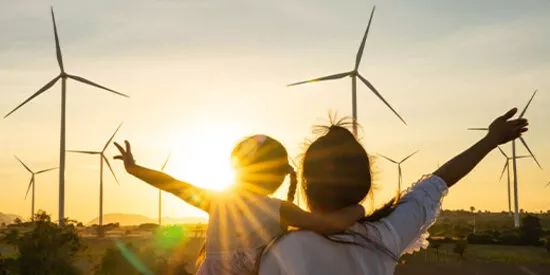
Renewing India: an energy transition that is well on the way
Every country is striving to reach net zero carbon emissions in the coming decades. But not all of them face India’s additional challenges of trying to decarbonise a rapidly growing economy, while also extending electricity coverage to a still largely rural population of 1.4 billion.
The investment required is enormous: the International Energy Agency believes it will take $160 billion a year until 2030 to get the country on track to reach net zero by 20701 – that’s almost $13 trillion. Many observers question whether India will be able to raise those sums and hit that target date given the multiple aims outlined above and its current dependency on fossil fuels. Coal still supplies 55% of total energy needs although in electricity generation terms, it is close to 75% of the mix2.
I am more optimistic. In fact, I believe that we can not only meet but actually beat these goals. What gives me confidence is the remarkable growth of the renewables sector. India is blessed with one of the highest solar and wind energy resource potentials in the world and cost of power already is cheaper than conventional, more carbon intensive sources. In 2019, the government set a target to build 500 Gigawatts of renewable energy by 2030. Four years later 180GW has already been installed with another 88GW in the near-term works. The Government has already directed a tripling in capacity that it will auction annually, going from 15GW to 50GW per year. But for Covid-19, progress would have been even more rapid3.
This is the work of a host of new generation of renewables/energy companies, of which a number are private companies. Some are increasingly adopting a ‘cradle-to-grave’ approach, not only developing and operating wind and solar farms but also getting involved in their manufacturing, construction, through in-house engineering arms; handling maintenance throughout the lifetime of the facility; and, at times, functioning as a partial offtaker of the power produced.
At the same time, their projects are growing in size with output of 1GW+ no longer unusual. Increasingly, they are building facilities that combine different types of renewable energy, from wind to solar to hydropower and that also include either battery storage or increasingly pumped hydro storage to compensate for the intermittency inherent in renewable energy. This facilitates so-called ‘RTC’ or’ round-the-clock’ power4, which is a game-changer for the industry.
In this respect, India’s size is actually an advantage. Growing demand can support ‘utility scale’ projects and a young, educated and expanding workforce can staff them. Another plus is the country’s sophisticated inter- and intra-state transmission infrastructure. This allows operators to build in optimal locations – solar farms in Rajasthan, wind parks in Karnataka, allowing the electrons to be delivered nationally, when needed.
While these large projects already enjoy economies of scale, making for competitive prices, the drive to fully localise supply chains will bring further cost benefits over time. Currently, a lot of sophisticated renewables equipment is still imported. However, the big developers are integrating vertically at speed, encouraged by government stipulations on local content.
New Delhi is helping with financial incentives as well, such as top-up tariffs over the life of a facility if it contains enough domestically manufactured kit. Critically, it has also become much quicker and easier to get permits and licenses, with the administration’s ‘one-stop-shop’ approach enabling some projects to go from financial close to commencing operations in under two years.
The government is also being bold when it comes to supporting cutting-edge clean technologies, specifically green hydrogen and ammonia. India is one of only six Asian countries to have a published hydrogen strategy, with details of required subsidies and investment levels. To generate demand, it lays down requirements for hard-to-abate industrial sectors like steel and chemicals to use a certain amount of clean hydrogen by 2030.
I believe India’s scale, cost competitiveness and skilled private sector firms leave it ideally positioned to become a global centre for green hydrogen and ammonia production, both as fuels and as transport vectors, for domestic consumption and, ultimately, for export. Such ability to access market will ultimately aid in accelerating the commercialization of these projects.
These advantages are not lost on investors and we see broad investor interest ranging from sovereign wealth funds and multi-lateral development banks, from institutional investors like the big Canadian pension funds, and from private finance – both in the form of private equity firms as well as infrastructure and debt providers.
A bank like Societe Generale can help connect such international institutions with our growing client list of Indian energy companies and renewables developers. And given our global experience in project finance, we are well placed to advise on long-term capital raising and structuring whilst assessing currency, market and project risks. We are delighted to be doing our part in accelerating a clean energy future for India.
1. India’s Clean Energy Transition - IEA
2. Ministry of Coal - Government of India
3. India to achieve 500GW renewables target – Economic Times
4. RTC Renewables – Societe Generale

China finds its feet: economic stability and gradual recovery in 2025
By Wei Yao, Head of Research and Chief Economist for APAC at Societe Generale.

Best of both worlds: How social ABS delivers low-cost financing and a positive impact
By Eugene Kim, Head of Securitisation and Fund Finance for Asia Pacific at Societe Generale.

Data centres are taking Asia-Pacific by storm
By Marie Vinnell, Chief Country Officer for Australia and Eugene Tan, Head of Technology, Media and Telecoms for Asia...

Societe Generale wins 10 awards in sustainable finance
Global Finance has announced the winners of its fifth annual Sustainable Finance Awards for 2025 and the selections for...
